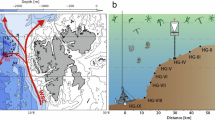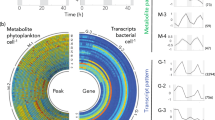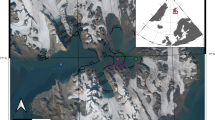Abstract
Deep-sea sediments cover ∼70% of Earth's surface and represent the largest interface between the biological and geological cycles of carbon. Diatoms and zooplankton faecal pellets naturally transport organic material from the upper ocean down to the deep seabed, but how these qualitatively different substrates affect the fate of carbon in this permanently cold environment remains unknown. We added equal quantities of 13C-labelled diatoms and faecal pellets to a cold water (−0.7 °C) sediment community retrieved from 1080 m in the Faroe-Shetland Channel, Northeast Atlantic, and quantified carbon mineralization and uptake by the resident bacteria and macrofauna over a 6-day period. High-quality, diatom-derived carbon was mineralized >300% faster than that from low-quality faecal pellets, demonstrating that qualitative differences in organic matter drive major changes in the residence time of carbon at the deep seabed. Benthic bacteria dominated biological carbon processing in our experiments, yet showed no evidence of resource quality-limited growth; they displayed lower growth efficiencies when respiring diatoms. These effects were consistent in contrasting months. We contend that respiration and growth in the resident sediment microbial communities were substrate and temperature limited, respectively. Our study has important implications for how future changes in the biochemical makeup of exported organic matter will affect the balance between mineralization and sequestration of organic carbon in the largest ecosystem on Earth.
Similar content being viewed by others
Log in or create a free account to read this content
Gain free access to this article, as well as selected content from this journal and more on nature.com
or
References
Andersson JH, Woulds C, Schwartz M, Cowie GL, Levin LA, Soetaert K et al. (2008). Short-term fate of phytodetritus in sediments across the Arabian Sea oxygen minimum zone. Biogeosciences 5: 43–53.
Apple JK, del Giorgio PA, Kemp WM . (2006). Temperature regulation of bacterial production, respiration and growth efficiency in a temperate salt-marsh estuary. Aquat Microb Ecol 43: 243–254.
Arnosti C, Jørgensen BB, Sagemann J, Thamdrup B . (1998). Temperature dependence of microbial degradation of organic matter in marine sediments: polysaccharide hydrolysis, oxygen consumption, and sulphate reduction. Mar Ecol Prog Ser 165: 59–70.
Bathmann UV, Noji TT, Voss M, Peinert R . (1987). Copepod fecal pellets: abundance, sedimentation and content at a permanent station in the Norwegian Sea in May/June 1986. Mar Ecol Prog Ser 38: 45–51.
Billett DSM, Lampitt RS, Rice AL, Mantoura RFC . (1983). Seasonal sedimentation of phytoplankton to the deep-sea benthos. Nature 302: 520–522.
Boetius A, Lochte K . (1996). Effect of organic enrichments on hydrolytic potentials and growth of bacteria in deep-sea sediments. Mar Ecol Prog Ser 140: 239–250.
Boschker HTS, Middelburg JJ . (2002). Stable isotopes and biomarkers in microbial ecology. FEMS Microb Ecol 40: 85–95.
Brinch-Iversen J, King GM . (1990). Effects of substrate concentration, growth state, and oxygen availability on relationships among bacterial carbon, nitrogen and phosphorus content. FEMS Microbiol Lett 74: 345–355.
Bühring SI, Lampadariou N, Moodley L, Tselepides A, Witte U . (2006). Benthic microbial and whole-community responses to different amounts of 13C-enriched algae: in situ experiments in the deep Cretan Sea (Eastern Mediterranean). Limnol Oceanogr 54: 157–165.
Burdige DJ . (2007). Preservation of organic matter in marine sediments: controls, mechanisms and an imbalance in sediment organic carbon budgets? Chem Rev 107: 467–485.
Clarke A . (1991). What is cold adaptation and how should we measure it? Amer Zool 31: 81–92.
Cowie GL, Hedges JI . (1996). Digestion and alteration of the biochemical constituents of a diatom (Thalassiosira weissflogii) ingested by an herbivorous zooplankton (Calanus pacificus). Limnol Oceanogr 41: 581–594.
Danovaro R, Dell’Anno A, Cordinaldesi C, Magagnini M, Noble R, Tamburini C et al. (2008). Major viral impact on the functioning of benthic deep-sea ecosystems. Nature 454: 1084–1087.
del Giorgio PA, Cole JJ . (1998). Bacterial growth efficiency in natural aquatic systems. Annu Rev Ecol Syst 29: 503–541.
Edwards M, Richardson AJ . (2004). Impact of climate change on marine pelagic phenology and trophic mismatch. Nature 430: 881–884.
Eloe EA, Malfatti F, Gutierrez J, Hardy K, Schmidt WE, Pogliano K et al. (2011). Isolation and characterization of a psychropiezophilic alphaproteobacterium. App Env Microbiol 77: 8145–8153.
Gontikaki E, Mayor DJ, Narayanaswamy BE, Witte W . (2011a). Feeding strategies of deep-sea sub-Arctic macrofauna of the Faroe-Shetland Channel: combining natural stable isotopes and enrichment techniques. Deep-Sea Res I 58: 160–172.
Gontikaki E, Mayor DJ, Thornton B, Black K, Witte U . (2011b). Processing of 13C-labelled diatoms by a bathyal community at sub-zero temperatures. Mar Ecol Prog Ser 421: 39–50.
Gooday AJ, Turley CM . (1990). Responses by benthic organisms to inputs of organic material to the ocean floor: a review. Phil Trans R Soc Lond A 331: 119–138.
Graf G . (1989). Benthic-pelagic coupling in a deep-sea benthic community. Nature 341: 437–439.
Hensen C, Zabel M, Schulz HN . (2006). Benthic cycling of oxygen, nitrogen and phosphorus. In Schulz HD, Zabel M (eds). Marine Geochemistry. Springer-Verlag: Berlin, pp 207–240.
Jahnke RA . (1996). The global ocean flux of particulate organic carbon: areal distribution and magnitude. Glob Biogeochem Cy 10: 71–88.
Karl DM, Bird DF, Björkman K, Houlihan T, Shacklford R, Tupas L . (1999). Microorganisms in the accreted ice of Lake Vostok, Antarctica. Science 286: 2144–2147.
Lampitt RS, Achterberg EP, Anderson TR, Hughes JA, Iglesias-Rodriguez MD, Kelly-Gerreyn BA et al. (2008). Ocean fertilization: a potential means of geoengineering? Phil Trans Roy Soc A 366: 3919–3945.
Lipp JS, Morono Y, Inagaki F, Hinrichs K-U . (2008). Significant contribution of archaea to extant biomass in marine subsurface sediments. Nature 454: 991–994.
Mayor DJ, Cook K, Thornton B, Walsham P, Witte UFM, Zuur AF et al. (2011). Absorption efficiencies and basal turnover of C, N and fatty acids in a marine Calanoid copepod. Funct Ecol 25: 509–518.
Meyer-Reil L-A, Köster M . (1992). Microbial life in pelagic sediments: the impact of environmental parameters on enzymatic degradation of organic material. Mar Ecol Prog Ser 81: 65–72.
Moodley L, Middelburg JJ, Soetaert K, Boschker HTS, Herman PMJ, Heip CHR . (2005). Similar rapid response to phytodetritus deposition in shallow and deep-sea sediments. J Mar Res 63: 457–469.
Muyzer G, de Waal EC, Uitterlinden AG . (1993). Profiling of complex microbial populations by denaturing gradient gel electrophoresis analysis of polymerase chain reaction-amplified genes encoding for 16S rRNA. Appl Environ Microbiol 59: 695–700.
Nicol GW, Campbell CD, Chapman SJ, Prosser JI . (2007). Afforestation of moorland leads to changes in crenarchaeal community structure. FEMS Microbiol Ecol 60: 51–59.
Persson J, Wojewodzic MW, Hessen DO, Andersen T . (2011). Increased risk of phosphorus limitation at higher temperatures for Daphnia magma. Oecologia 165: 123–129.
Pomeroy LR, Wiebe WJ . (2001). Temperature and substrates as interactive limiting factors for marine heterotrophic bacteria. Aquat Microb Ecol 23: 187–204.
R Development Core Team. (2010). R: A Language and Environment for Statistical Computing. R Foundation for Statistical Computing, Vienna. Available at: http://www.R-project.org.
Ruhl HA, Ellena JA, Smith Jr KL . (2008). Connections between climate, food limitation, and carbon cycling in abyssal sediment communities. Proc Natl Acad Sci USA 105: 17006–17011.
Sahm K, Berninger U-G . (1998). Abundance, vertical distribution, and community structure of benthic prokaryotes from permanently cold marine sediments (Svalbard, Arctic Ocean). Mar Ecol Prog Ser 165: 71–80.
Schlüter M, Sauter EJ, Schäfer A, Ritzrau W . (2000). Spatial budget of organic carbon flux to the seafloor of the northern North Atlantic (60°N - 80°N). Glob Biogeochem Cy 14: 329–340.
Shiah F-K, Ducklow HW . (1994). Temperature and substrate regulation of bacterial abundance, production and specific growth rate in Chesapeake Bay, USA. Mar Ecol Prog Ser 103: 297–308.
Smith CR, Berelson W, Demaster DJ, Dobbs FC, Hammond D, Hoover DJ et al. (1997). Latitudinal variations in benthic processes in the abyssal equatorial Pacific:control by biogenic particle flux. Deep-Sea Res II 44: 2295–2317.
Thornton B, Zhang Z, Mayes RW, Högberg MN, Midwood AJ . (2011). Can gas chromatography combustion isotope ratio mass spectrometry be used to quantify organic compound abundance? Rapid Commun Mass Sp 25: 2433–2438.
Van Nugteren P, Herman PMJ, Moodley L, Middelburg JJ, Vos M, Heip CHR . (2009). Spatial distribution of detrital resources determines the outcome of competition between bacteria and a facultative detritivorous worm. Limnol Oceanogr 54: 1413–1419.
Vetriani C, Jannasch HW, MacGreggor BJ, Stahl DA, Reysenbach A-L . (1999). Population structure and phylogenetic characterization of marine benthic archaea in deep-sea sediments. App Env Microbiol 65: 4375–4384.
Vetter YA, Deming JW, Jumars PA, Krieger-Brockett BB . (1998). A predictive model of bacterial foraging by means of freely released extracellular enzymes. Microb Ecol 36: 75–92.
White DC, Davis WM, Nickels JS, King JD, Bobbie RJ . (1979). Determination of the sedimentary microbial biomass by extractible lipid phosphate. Oecologia 40: 51–62.
Wirsen CO, Molyneaux SJ . (1999). A study of deep-sea natural microbial populations and barophilic pure cultures using a high-pressure chemostat. App Env Microbiol 65: 5314–5321.
Witte U, Wenzhöfer F, Sommer S, Boetius A, Heinz P, Aberle N et al. (2003). In situ experimental evidence of the fate of a phytodetritus pulse at the abyssal sea floor. Nature 424: 763–766.
Wolff GA, Billett DSM, Bett BJ, Holtvoeth J, FitzGeorge-Balfour T, Fisher EH et al. (2011). The effects of natural iron fertilisation on deep-sea ecology: the Crozet Plateau, Southern Indian Ocean. PLoS One 6: e20697.
Woulds C, Cowie GL, Levin LA, Andersson JH, Middelburg JJ, Vandewiele S et al. (2007). Oxygen as a control on seafloor biological communities and their roles in sedimentary carbon cycling. Limnol Oceanorg 52: 1698–1709.
Yayanos AA . (1986). Evolutinoal and ecological implications of the properties of deep-sea barophilic bacteria. Proc Natl Acad Sci USA 83: 9542–9546.
Zuur AF, Ieno EN, Walker NJ, Saveliev AA, Smith GM . (2009). Mixed-Effects Models and Extensions in Ecology with R. Springer: New York.
Zuur AF, Ieno EN, Elphick CS . (2010). A protocol for data exploration to avoid common statistical problems. Method Ecol Evolut 1: 3–14.
Acknowledgements
This research was funded by the Leverhulme Trust (F/00152/T) and supported by NERC's Life Sciences Mass Spectrometry Facility (EK116-11-07). DJM is currently funded by NERC (NE/G014744/1). BT received funding from the Rural and Environment Science and Analytical Services Division (RESAS) of the Scottish Government. We gratefully acknowledge G Slesser and all those that sailed onboard FRV Scotia (Marine Scotland Science). Thanks to E Lines for field assistance, M Machairopoulou for macrofauna identification, M Procee, G Martin and PJ Martin for logistical support, E Gontikaki and A Douglas for thoughtful discussions, J Newton for the elemental and IRMS analysis of bulk sediment samples and various colleagues and three anonymous reviewers for their constructive input on an earlier draft of this manuscript. DJM thanks TR Anderson for his continued mentorship.
Author contributions
DJM designed and performed the research; DJM and BT analysed the samples; DJM and AFZ analysed the data; DJM wrote the paper and all co-authors commented; SH, DJM and UFMW co-authored the original grant.
Author information
Authors and Affiliations
Corresponding author
Additional information
Supplementary Information accompanies the paper on The ISME Journal website
Rights and permissions
About this article
Cite this article
Mayor, D., Thornton, B., Hay, S. et al. Resource quality affects carbon cycling in deep-sea sediments. ISME J 6, 1740–1748 (2012). https://doi.org/10.1038/ismej.2012.14
Received:
Revised:
Accepted:
Published:
Issue date:
DOI: https://doi.org/10.1038/ismej.2012.14
Keywords
This article is cited by
-
The carbon partitioning of glucose and DIC in mixotrophic, heterotrophic and photoautotrophic cultures of Tetraselmis suecica
Biotechnology Letters (2021)
-
Detecting the presence of fish farm-derived organic matter at the seafloor using stable isotope analysis of phospholipid fatty acids
Scientific Reports (2017)



